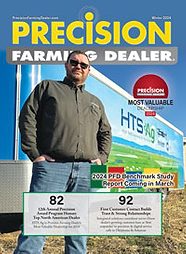As precision farming practices continue to infiltrate more farms overall, technology is an essential part of strip-tillers’ operations. Talking with farm equipment dealers, several have cited strip-till products as an emerging opportunity to complement sales of GPS systems and RTK subscriptions.
“Strip-till is definitely an area where we see growth potential,” says one precision dealer in Ohio. “Precise placement of fertilizer and the ability to plant into that strip lends itself to the need for RTK-level accuracy.”
This notion is supported by the results of our sister publication No-Till Farmer’s “2nd Annual Strip-Till Operational Benchmark Study,” published in the Summer edition of Conservation Tillage Guide.
According to the survey of nearly 200 strip-tillers throughout the U.S., 79.4% said they use RTK-level GPS correction, which is nearly a 10% increase compared to 2014 (70.3%). While many strip-tillers consider RTK critical to the success of their operation, 7.9% said they don’t use any type of GPS in their strip-till operation, down from 15.6% in 2014.
Although the pool of strip-tillers not using GPS may be shrinking, that doesn’t mean dealers are limited to only pursuing RTK-related sales for these farmers. Variable-rate fertilization is an increasingly popular, yet still a new practice that strip-tillers are adopting.
According to the benchmark study, use of variable-rate fertilizer application increased from 31.5% last year to 36.2% in 2015. As farmers keep a closer eye on input costs, and payback from the technology investment becomes more tangible, it will be worth seeing if this percentage continues to grow.
One area of precision farming that didn’t gain momentum with strip-tillers was use of implement guidance, which remained stagnant at 19.7% this year compared to 20.3% in 2014. In some cases, adoption of this technology may still be cost-prohibitive, depending on whether farmers want to invest in active or passive implement guidance systems.
A further breakdown of survey respondents analyzed the top 25% of strip-tillers by corn and soybean yields, and their usage of precision farming practices. Not surprisingly, 93.2% said they use RTK, well above the overall group percentage (79.4%). However, a smaller percentage (34.1%) of the top strip-tillers use variable-rate fertilization practices and only 17% use implement guidance technology.
It will be interesting to see if more dealers look to tap into the strip-till market, by either directly selling equipment to farmers, or leveraging their precision relationships to expand the scope of technology being used by those customers.







Post a comment
Report Abusive Comment